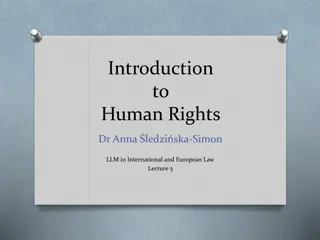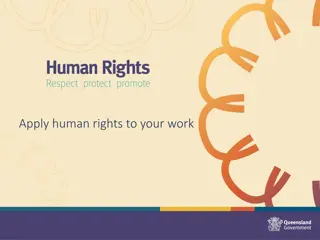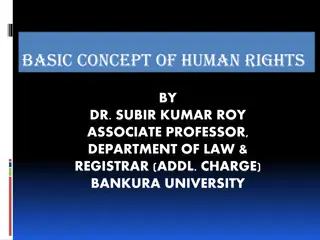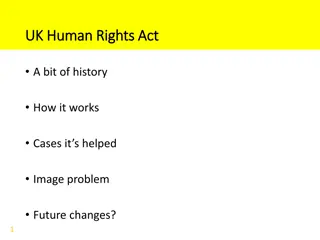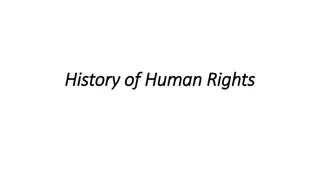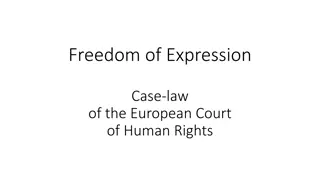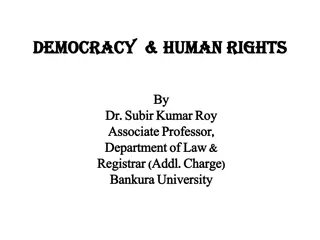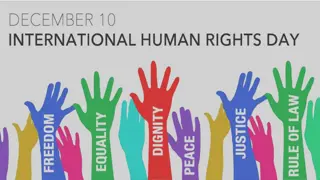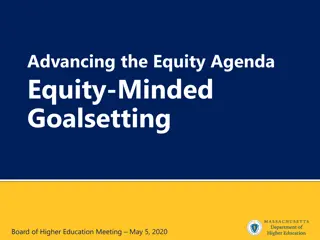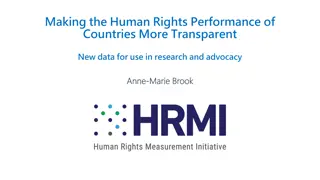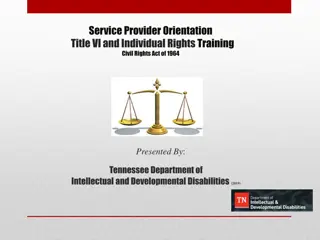
Introducing Human Rights and Equity in Education with Anti-Racism Focus
This professional learning resource introduces district school boards to a year-long program focusing on human rights, anti-oppression, anti-colonial education, and addressing anti-Indigenous and anti-Black racism in education. The resource aims to equip educators and school board staff to confront discrimination and promote inclusivity in Ontario schools.
Download Presentation

Please find below an Image/Link to download the presentation.
The content on the website is provided AS IS for your information and personal use only. It may not be sold, licensed, or shared on other websites without obtaining consent from the author. If you encounter any issues during the download, it is possible that the publisher has removed the file from their server.
You are allowed to download the files provided on this website for personal or commercial use, subject to the condition that they are used lawfully. All files are the property of their respective owners.
The content on the website is provided AS IS for your information and personal use only. It may not be sold, licensed, or shared on other websites without obtaining consent from the author.
E N D
Presentation Transcript
Professional Learning Resource: Introduction to Human Rights and Equity in Education: Anti- Racism and Anti-Discrimination
Resource Overview for Facilitators This resource is designed to introduce district school boards to a year of learning, dialogue and reflection about human rights, anti-oppression and anti-colonial education, and confronting anti-Indigenous and anti-Black racism in education. This learning will equip educators and school board staff to address discrimination based on all Ontario Human Rights Code grounds including, for example, anti-Asian racism amplified through the COVID-19 pandemic. The ministry is committed to upholding and promoting human rights as well as addressing and eliminating all forms of discrimination experienced by students, families, staff and school communities in Ontario. Concerns about anti-Indigenous and anti-Black racism are long-standing, and our government is committed to working with all communities, to create safe and inclusive spaces. Through an anti- colonial approach, we are committed to working with school boards, education partners and all communities to eradicate disparities in outcomes for Indigenous and Black students and families. Introduction to Anti-Racism and Anti-Discrimination - Human Rights and Equity in Education 2
Resource Overview for Facilitators (Continued) This resource will provide a starting point to equip educators/leaders with the knowledge they must have to promote and uphold human rights as required under the Ontario Human Rights Code and address discriminatory policies and practices. Effectively dismantling systemic barriers requires school boards to build internal capacity among school leadership and staff to better understand how current structures and systems violate human rights and perpetuate racism and discrimination. Throughout the school year, the ministry will support boards to build knowledge and skills necessary to eradicate disparities in outcomes for marginalized students and families. This deck has been designed in a modular format so that it can easily be adapted to board specific contexts and audiences and can be used at any time to support training (i.e. at the start of the school year or later). Boards are encouraged to add their own reflective questions and activities, as well as local board specific content to this deck. Please note for in-person training: Medical masks and eye protection (i.e. face shields) must be provided for all staff. All staff participants are required to wear masks, with reasonable exceptions for medical conditions and disabilities as identified by staff to their supervisor/employer. Introduction to Anti-Racism and Anti-Discrimination - Human Rights and Equity in Education 3
Planning for Training The following should be considered when planning for in-person staff training: How many staff can the facility accommodate while still ensuring appropriate physical distancing? How might training be designed to allow for smaller gatherings in multiple locations within a facility? How can seating be arranged to ensure physical distancing? (Multiple training sessions may be required, or you may want to consider the use of remote/online learning/training solutions.) How will Personal Protective Equipment (PPE) be administered in a safe way that avoids unnecessary congestion? What are some ways you can incorporate small group tasks into the sessions being facilitated? Consider that staff should continue to maintain physical distancing and wear masks. 4
Planning for Training (Continued) What are some safety protocols to share with educators before beginning the training? (Staff should be asked to take the self-assessment, encouraged to not exchange writing supplies, and to maintain proper hand hygiene. Hand sanitizers should always be available, personal devices, rather than chart paper, could be used to contribute to any collaborative documents.) How can signage help ensure staff follow health and safety protocols? Consideration should be given to avoiding congestion points such as entering and exiting the facility and lunch, signage on washrooms with maximum occupancy, etc. If this is the first training session for staff, what key messages might you use and actions might you take to recognize the mental health and well-being of staff, reduce feelings of anxiety and build community to set a positive tone for training? 5
Overview Each chapter addressed in this resource is intended to start and support important conversations 1. What is a human rights approach to education and why it is critical 2. Introduction to understanding what colonialism is and how to confront it 3. Introduction to understanding what is anti-Black racism and how to confront it 4. Upholding and promoting human rights and equity in the context of the COVID-19 pandemic. 5. Next steps for on-going series of professional learning 6. Resources 7. Equity concepts in human rights terms Introduction to Anti-Racism and Anti-Discrimination - Human Rights and Equity in Education 6
Acknowledging Indigenous Lands and Beyond Some key questions to consider: Do I understand the history of how colonization in these lands has displaced and denied the inherent rights of the original peoples of the land? What are my treaty responsibilities? How am I upholding my treaty obligations? Introduction to Anti-Racism and Anti-Discrimination - Human Rights and Equity in Education 7
Module 1: What is a Human Rights Approach to Education?
What is a human rights approach to education? A human rights approach to education focuses on how we learn and work together together, ensuring that every student's right to education is respected and realized and all members of the school community are welcome and included. A human rights approach to education: Seeks to realize the rights and values set out in theOntario Human Rights Code Supports legal compliance through system-wide actions to provide inclusive environments, and prevent and respond to discrimination Understands the primacy of the Human Rights Code over other laws in the province Honours, where applicable, the values in the Universal Declaration of Human Rights, the United Nations Declaration on the Rights of Indigenous Peoples and other international human rights agreements to which Canada is committed Introduction to Anti-Racism and Anti-Discrimination - Human Rights and Equity in Education 9
What is a human rights approach to education? A human rights approach to education... Acknowledges the overlapping, interdependent relationship between equity and human rights Respects the shared principles underpinning international agreements, equity work, and Ontario's Human Rights Code: Inherent dignity and worth Equal rights and opportunity Freedom from discrimination Creating a climate of understanding and mutual respect, so each person feels a part of the community and able to participate fully Introduction to Anti-Racism and Anti-Discrimination - Human Rights and Equity in Education 10
Why is a human rights approach critical? It fosters cultures that uphold, respect and promote human rights, including: Fostering the well-being of all students, and school staff, to enable them to thrive Supporting students' right to equality in education, and staff's right to equality in employment Promoting equality of experience and outcomes, to enables all to reach their full potential, and create a more just society To achieve this the education system must address: Persistent concerns regarding harassment and discrimination in education over many years, raised by Indigenous, Black, racialized, LGBTQ2S communities, people with disabilities, and others Qualitative research and statistical data showing disparities in educational experiences and outcomes for many of these groups in education, and that these are worsening Human rights complaints against school boards Introduction to Anti-Racism and Anti-Discrimination - Human Rights and Equity in Education 11
Why is a human rights approach critical? (Continued) The human rights approach raises awareness of and directly addresses system-wide obligations to provide inclusion, prevent discrimination and remove barriers, and respond effectively when things go wrong Fostering cultures that uphold, respect and promote human rights facilitates the prevention and resolution of human rights concerns in a more systemic, timely and reparative way. Introduction to Anti-Racism and Anti-Discrimination - Human Rights and Equity in Education 12
Reflective Activity Placeholder (See Speaker Notes) Introduction to Anti-Racism and Anti-Discrimination - Human Rights and Equity in Education 13
Human Rights Code: Social Areas The Code provides for equality and freedom from discrimination in: Goods, Services & Facilities Contracts Housing Unions and professional associations Employment applies to the extended environment Introduction to Anti-Racism and Anti-Discrimination - Human Rights and Equity in Education 14
Reflective Activity Placeholder (See Speaker Notes) 15
Human Rights Code: Grounds Race Colour Ancestry Ethnic origin Citizenship Place of origin Public assistance (in housing only) Record of offences (employment, if pardoned) Disability Age Sex (incl. pregnancy, breastfeeding) Gender identity Gender expression Sexual orientation Marital status Family status Creed Introduction to Anti-Racism and Anti-Discrimination - Human Rights and Equity in Education 16
Reflective Activity Placeholder (See Speaker Notes) 17
Discrimination is: Code Social Area + Code Ground(s) + Differential Impact = Discrimination Discrimination is treating someone unfairly relating to personal characteristics (Code grounds), by either: imposing a burden, or denying a privilege, benefit or opportunity enjoyed by others Introduction to Anti-Racism and Anti-Discrimination - Human Rights and Equity in Education 18
Discrimination can be... Direct Indirect Subtle Unintentional Introduction to Anti-Racism and Anti-Discrimination - Human Rights and Equity in Education 19
Forms of discrimination Examples of common forms of discrimination include: Harassment Poisoned environment Systemic discrimination Reprisal Condonation Impact, rather than intent, is key Introduction to Anti-Racism and Anti-Discrimination - Human Rights and Equity in Education 20
Systemic Discrimination The Ontario Human Rights Commission s Policy and guidelines on racism and racial discrimination identifies 3 considerations for identifying and assessing systemic discrimination: Policies, Practices and Decision-Making Processes Organizational Culture Numerical Data Introduction to Anti-Racism and Anti-Discrimination - Human Rights and Equity in Education 21
Organizational Responsibility Organizations are: Required to provide an inclusive environment, free from discrimination and harassment Liable for the actions or inaction of employees and management Obligated to respond appropriately when discrimination or harassment occurs, such as Progressive measures/sanctions for repeated behaviours Remedies to address impact on the environment Systemic remedies to prevent recurrence Introduction to Anti-Racism and Anti-Discrimination - Human Rights and Equity in Education 22
Organizational Responsibility In order to be consistent with the Code and Code values expressed in the case law, organizations must maintain accessible, inclusive, and discrimination & harassment-free environments by taking among other things the following steps to prevent & respond to discrimination: Design inclusively Identify how rules, policies, requirements, practices, etc. may be creating barriers Remove barriers to equality of outcomes Accommodate needs related to Code grounds Not condone, ignore or continue any discriminatory acts Respond appropriately to human rights concerns and complaints Introduction to Anti-Racism and Anti-Discrimination - Human Rights and Equity in Education 23
Module 2: Introduction to understanding what colonialism is and how you confront it
What is colonization? Colonization involves one society seeking to conquer another and then rule it. Colonization in Canada took the form of settler colonialism where European settlers settled permanently on Indigenous lands and aggressively seized those lands from Indigenous people. Canada's vision for Indigenous peoples was one of assimilation and abolishing language and culture. Colonial systems and structures continue to cause great harm to Indigenous peoples. It is critical to look at the truth of Canada's past and present to understand the history of the lands we live on and the harm that has been done to its original peoples. Introduction to Anti-Racism and Anti-Discrimination - Human Rights and Equity in Education 25
What is colonialism? There are different forms of colonialism. In the context of the land now refer to as Canada, settler colonialism captures the experience on this land. "In settler colonialism, foreign people move into a region, and occupy and claim ownership of the land. They alter the territories, social structures, government and economy. They often maintain a temporary allegiance to homeland and draw legitimacy from both worlds. This form of colonization leads, by a variety of means, to depopulation, or attempts at depopulation, of the previous inhabitants so that settlers can take over the land." Heller and McElhinny. (2017). Language, Capitalism, Colonialism: Toward a Critical History, pg.30 Introduction to Anti-Racism and Anti-Discrimination - Human Rights and Equity in Education 26
Confronting Colonialism Confronting colonialism is: Acknowledging the impacts of colonization in Canada and taking action to make change About building relationships with Indigenous people and communities and working together to make change Thinking about dominant structures that work for some and not for others Looking at student achievement data and thinking about who is succeeding and who is not About examining colonial systems, policies and practices Wondering who has the power, who is in the room, which voices are being heard, who is making decisions and then thinking about who is not there Understanding power and privilege Introduction to Anti-Racism and Anti-Discrimination - Human Rights and Equity in Education 27
Reflective Activity Placeholder See Speaking Notes Introduction to Anti-Racism and Anti-Discrimination - Human Rights and Equity in Education 28
Module 3: Introduction to understanding what is anti-Black racism and how you confront it
What is Anti-Black Racism? Anti-Black racism is prejudice in attitudes and beliefs, stereotyping and discrimination that is directed at people of African descent and is rooted in their unique history and experience of enslavement and its legacy. Anti-Black racism is deeply entrenched in Canadian institutions, policies and practices, to the extent that anti-Black racism is either functionally normalized or rendered invisible to the larger society. Anti-Black racism manifests in the current educational marginalization of African Canadians, which includes unequal opportunities, disproportionately low academic achievement, lessened experiences of well-being, and overrepresentation in the disciplinary and Special Education data. (from: Ontario Anti-Racism Act, 2017) Introduction to Anti-Racism and Anti-Discrimination - Human Rights and Equity in Education 30
Confronting Anti-Black Racism - Introduction Under the OHRC and human rights case law: The Code recognizes the inherent worth and dignity of every person in Ontario. The creation of a society in which all persons can live and work in an environment that is free from discrimination is central to why we must confront anti-Black racism in Ontario schools. Every person in Ontario has the right to be free from racial discrimination and harassment in the social areas of employment, services, goods, facilities, housing accommodation, contracts and membership in trade and vocational associations. Education is a service and educators must take proactive steps to make sure they are not taking part in, condoning or allowing racial discrimination or harassment to happen. Introduction to Anti-Racism and Anti-Discrimination - Human Rights and Equity in Education 31
Reflective Activity Placeholder See Speaking Notes Introduction to Anti-Racism and Anti-Discrimination - Human Rights and Equity in Education 32
Ethical Obligations As per the Ontario College of Teachers Standards of Practice: Commitment to Students and Student Learning: Members are dedicated in their care and commitment to students. They treat students equitably and with respect and are sensitive to factors that influence individual student learning. Leadership in Learning Communities: Members promote and participate in the creation of collaborative, safe and supportive learning communities. Introduction to Anti-Racism and Anti-Discrimination - Human Rights and Equity in Education 33
Confronting Anti-Black Racism - Introduction Introduction to Anti-Racism and Anti-Discrimination - Human Rights and Equity in Education 34
Reflective Activity Using Data to Drive Decision- Making Consider using data on: Achievement & Learning Skills Academic placement Well-being EQAO/OSSLT School climate surveys Special education identifications Awards and scholarships Extra and co-curricular engagement Discipline What do you know about the experiences of the Black students in your school community? How do you know it? It is important to review data sets to gather a fulsome picture of how students are experiencing schooling. Introduction to Anti-Racism and Anti-Discrimination - Human Rights and Equity in Education 35
Module 4: Upholding and promoting human rights and equity in the context of the COVID-19 pandemic
Reflective Activity for School and System Leaders With a return to school and use of broad-based remote learning, existing disparities in learning and well-being among underserved students may become exacerbated. How can system leaders, school leaders and educators best serve students, families, and communities across the province during this time? What are some promising practices that can support the ongoing development of educator supports for learning environments to address these disparities and create conditions to ensure opportunities for all students to achieve their full potential? Introduction to Anti-Racism and Anti-Discrimination - Human Rights and Equity in Education 37
Reflective Activity for School and System Leaders How can schools and educatorspromote a positive learning climate that is inclusive of all students? How can they provide responsive and relevant content and pedagogies? What are some promising practices to: Maintain expectations for well-being and learning? Value identities and experiences? Enhance critical consciousness? Introduction to Anti-Racism and Anti-Discrimination - Human Rights and Equity in Education 38
Next Steps for Ongoing Professional Learning Opportunities
Highlights of Upcoming Human Rights and Equity Professional Learning for Educators Ongoing ministry supported professional learning throughout the 2020-21 school year focused on topics such as: Eradicating anti-Indigenous & anti-Black racism in the education system Addressing bias (self and system contexts) Implementing Anti-Oppressive Practice Culturally Responsive and Relevant Pedagogy Introduction to Anti-Racism and Anti-Discrimination - Human Rights and Equity in Education 40
United Nation Resources Resource Link Short Description https://www.un.org/esa/socdev/unpfii/document s/DRIPS_en.pdf United Nations Declaration on the Rights of Indigenous People Universal Declaration on Human Rights https://www.un.org/en/udhrbook/pdf/udhr_bookl et_en_web.pdf https://www.un.org/en/observances/decade- people-african-descent International Decade for People of African Descent 2015- 2024 Introduction to Anti-Racism and Anti-Discrimination - Human Rights and Equity in Education 42
Ontario Human Rights Commission Resources Resource Link Short Description http://www.ohrc.on.ca/en/learning/elearning/call-it- out Call it Out: Racism, racial discrimination and human rights , Ontario Human Rights Commission (e-Learning) http://www.ohrc.on.ca/en/learning/human-rights- 101 Human Rights101 , Ontario Human Rights Commission (webinar) http://www.ohrc.on.ca/en/learning/elearning/call-it- out Call it Out: Racism, racial discrimination and human rights , Ontario Human Rights Commission (e-Learning) http://www.ohrc.on.ca/en/learning/human-rights- 101 Human Rights101 , Ontario Human Rights Commission (webinar) Introduction to Anti-Racism and Anti-Discrimination - Human Rights and Equity in Education 43
Ontario Human Rights Commission Resources Resource Link Short Description http://www.ohrc.on.ca/en/learning/elearning/call-it- out Call it Out: Racism, racial discrimination and human rights , Ontario Human Rights Commission (e-Learning) http://www.ohrc.on.ca/en/learning/human-rights- 101 Human Rights101 , Ontario Human Rights Commission (webinar) http://www.ohrc.on.ca/en/learning/elearning/call-it- out Call it Out: Racism, racial discrimination and human rights , Ontario Human Rights Commission (e-Learning) http://www.ohrc.on.ca/en/learning/human-rights- 101 Human Rights101 , Ontario Human Rights Commission (webinar) Introduction to Anti-Racism and Anti-Discrimination - Human Rights and Equity in Education 44
Ontario Human Rights Code Resources Resource Link Short Description http://www.ohrc.on.ca/en/policy-and-guidelines- racism-and-racial-discrimination Policy and Guidelines on racism and racial discrimination http://www.ohrc.on.ca/en/our_work/policies_guideli nes Policies on creed, competing rights, sexual and gender-based harassment, gender identity, mental health, sexual orientation http://www.ohrc.on.ca/en/teaching-human-rights- ontario-guide-ontario-schools Teaching human rights in Ontario A guide for Ontario schools http://www.ohrc.on.ca/en/guide-your-rights-and- responsibilities-under-human-rights-code-0 Guide to your rights and responsibilities under the Human Rights Code Introduction to Anti-Racism and Anti-Discrimination - Human Rights and Equity in Education 45
Equity concepts in human rights language Equity Term Human Rights Term (if related to a Human Rights Code ground) Bullying Most likely harassment but also possibly discrimination or poisoned environment Poisoned environment Combination of many incidents of individual discrimination, harassment, and cases of systemic discrimination, as well as actions not covered under human rights law Code grounds, or protected grounds Negative school climate or toxic environment Oppression Social Identities Equity Equality of experiences and outcomes Introduction to Anti-Racism and Anti-Discrimination - Human Rights and Equity in Education 46


